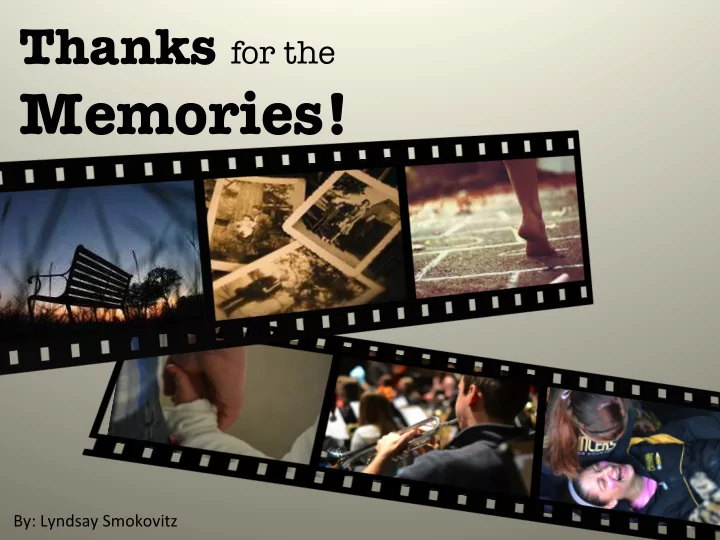

Thanks for the Memories! By: ¡Lyndsay ¡Smokovitz ¡
Introduction hLp://mercercogni>vepsychology.pbworks.com/f/1290909633/memory.jpg ¡ • Elizabeth ¡Lo:us ¡ ¡ • Cogni>ve ¡Psychologist ¡ Who? ¡ • A ¡ques>on ¡that ¡contains ¡a ¡false ¡presupposi>on ¡ allows ¡the ¡brain ¡to ¡incorporate ¡new, ¡false ¡ informa>on ¡into ¡the ¡memory ¡ ¡ Hypothesis? ¡ ¡ hLp://mercercogni>vepsychology.pbworks.com/f/1290909633/memory.jpg ¡ • The ¡memory ¡is ¡not ¡recalled, ¡but ¡reconstructed ¡ • Four ¡experiments ¡were ¡conducted ¡ ¡ • Each ¡experiment ¡tested ¡memory ¡with ¡a ¡false ¡ presupposi>on ¡ ¡ What ¡next? ¡ pre·sup·po·si·tion Something that is implied and must be true for statement to make sense
Experiment I Objective: Alter memory using a false presupposition • 150 participants were shown a 60% ¡ traffic accident video clip involving a car that ran a stop 50% ¡ sign 40% ¡ • Participants then answered 10 30% ¡ questions • đ of the group ( Group A ) 20% ¡ received the question: 10% ¡ “How fast was car A going when it turned right?” 0% ¡ 35% 53% • Other đ ( Group B ) received: Group ¡ Group ¡ A ¡ B ¡ “How fast was car going when it ran stop sign?” Participants who claimed to have seen a stop sign • Both groups were then asked if they saw a stop sign
Experiment II Objective: Alter memory using presupposition and delayed memory test • 40 participants viewed clip of class being disrupted by 8 antiwar demonstrators • Were then given 20 questions (all but 1 question was identical): • đ of participants ( Group C ) were asked: “Was the leader of the 4 demonstrators male?” • Other đ ( Group D ) were asked: “Was the leader of the 12 demonstrators male?” ¡ • After 1 week, participants returned to answer: Group ¡D ¡ “How many demonstrators did you see 8.85 in the classroom?” Group ¡C ¡ 6.4 0 ¡ 2 ¡ 4 ¡ 6 ¡ 8 ¡ 10 ¡
Experiment III Objective: Altered memory to include objects that never existed in original event • 150 university students watched a video involving a white sports car accident • After video, participants answered 10 questions: • đ of participants ( Group E ) were asked: “How fast was the white car going when it passed the barn on the country road?” • Other đ ( Group F ) were asked: “ How fast was the white car going on the country road?” Participants returned to • answer 10 new questions Group ¡F ¡ 2.7% Group ¡E ¡ 17.3% 0.00% ¡ 5.00% ¡ 10.00% ¡ 15.00% ¡ 20.00% ¡ Participants that claimed to have seen a barn
Experiment IV Objective: Demonstrated how memory would adjust to the mention of an object that never existed in the original event • 150 participants viewed a film involving 29.2% 30% ¡ a collision between a car and a man pushing a baby carriage 25% ¡ • Answered questionnaire containing 40 20% ¡ filler questions and these 5 key 15.6% questions: 15% ¡ • Group G answered direct questions: “ Did you see a barn in the film?” 10% ¡ 8.4% • Group H answered questions 5% ¡ containing false presuppositions: “Did you see a station wagon parked in 0% ¡ the front of the barn?” Group ¡ Group ¡ Group ¡ • Group I is the control group and G ¡ H ¡ I ¡ only answered the 40 filler The above percentages were the amount who questions saw the objects that were never part of the original event.
Data Concluded/Results: Data ¡shows ¡that ¡the ¡par>cipants’ ¡memory ¡was ¡altered ¡to ¡fit ¡what ¡the ¡presupposi>on ¡implied. ¡ ¡ Experiment I Experiment II • A larger amount of Group B • On average, the groups claimed to claimed to have seen a stop sign have seen a number near the presupposed number Stop sign is the presupposition • Questions contained an implied number • of antiwar demonstrators Experiment III Experiment IV The data from the direct question • • The barn is implied to exist in the group shows that just the mention of question an object will alter memory • There was a 14.6% difference Greatest amount of participants to see • between the two groups nonexistent object False presupposition group was • Group that received the question with • second to experience the impact a false presupposition had a greater amount of participants claim to see Implication alters memory • the barn
Real World Application • It is important to question the reliability of memory as a resource • Inaccuracy of an eyewitness’ memory in a court case • Memory is taken through a process from time of event to trial • Police interviews, “dinner-table stories”, revisiting memory after event, and retelling event at trial • Each time a memory is recalled, the neural pathways are altered • According to National Geographic, in 2014 4.1% of individual’s on trial were falsely convicted
Personal Application • Have you ever reminisced in your favorite memory with your best friend? • Two different perspectives are brought to light, but neither are right • Both memories have been reconstructed overtime • When trying to resolve a two-sided conflict • Remember human error in recalling memory
Works Cited Hock, R. R. (2013). Forty Studies that Changed Psychology: Explorations into the History of Psychological Research. Boston: Pearson Education, Inc. Ciccarelli, S., White, J. N., (2013). Psychology. Boston: Pearson Education, Inc. All images are personal property except for the following: Edgar, J. (Photographer). (2011). Retrieved April 20, 2015, from: http://edgarjaquez.deviantart.com Retrieved April 20, 2015, from: http://www.rosiesandz.com Childhood Memories [Photograph]. (2010). Retrieved April 20, 2015, from: http://scribbles1337.deviantart.com Pham, H. X. (Photographer). (2013). Retrieved April 20, 2015, from: http://www.slate.com/articles Retrieved April 20, 2015, from: http://mercercognitivepsychology.pbworks.com Retrieved April 20, 2015, from: http://www.viralnovelty.net Retrieved April 20, 2015, from: http://picturequotes.info/images/dory-fish-meme Retrieved April 20, 2015, from: http://thumbs.dreamstime.com
Thank you!
Recommend
More recommend